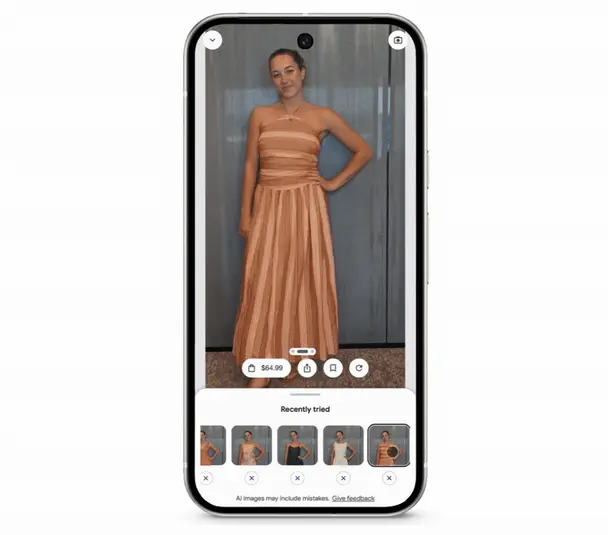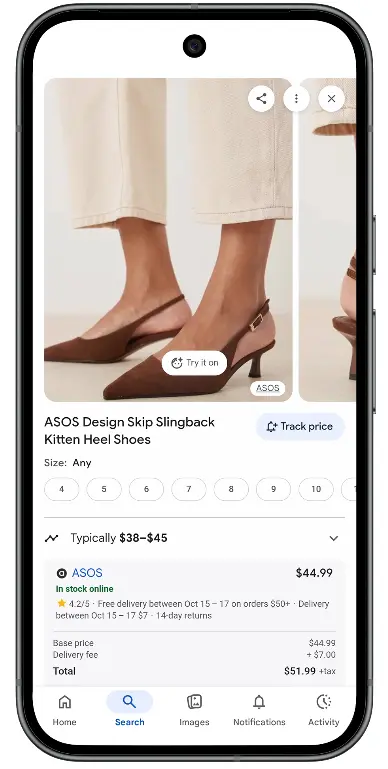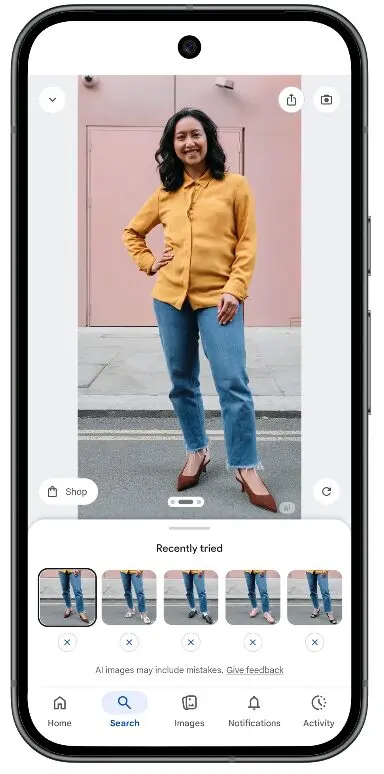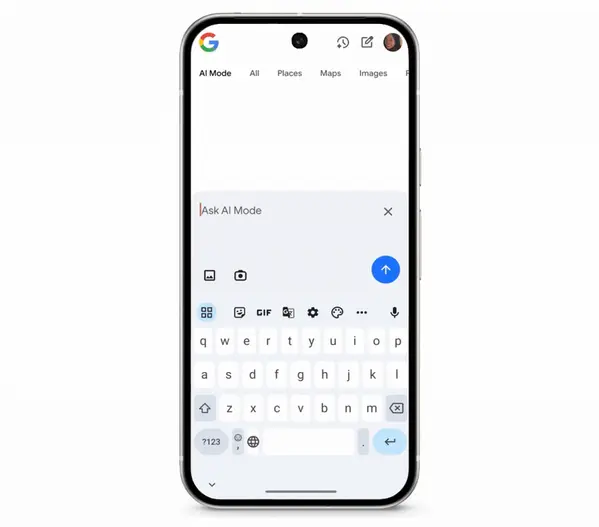- Google’s AI “try it on” tool now lets U.S. users virtually model apparel in Search, Shopping, and Images.
- Enhanced price alerts allow tracking by size, color, and target price across the entire web.
- Vision Match in AI Mode transforms simple text prompts into shoppable outfit and home‑decor galleries.
- These AI features are deeply integrated across Google’s platforms to deliver a unified shopping experience.
- Brands should tailor assets for virtual try‑on, leverage dynamic pricing alerts, and supply high‑quality inspiration visuals.
See how you can upload your photo and preview outfits across Search, Shopping, and Images.
Google is rewriting the shopping rules once again. This time, it’s not about faster delivery or expanded inventory; it’s about bringing the fitting room directly to your screen. With the rollout of its AI‑powered virtual try‑on tool, Google Shopping is offering shoppers a chance to “try on” garments from the billions of items in its Shopping Graph, all without leaving their homes.
This innovation promises to bridge the gap between online browsing and the tactile confidence typically reserved for in‑store shopping.
From Lab Experiment to Living Room Closet
Earlier this year, at Google I/O, the company teased a limited‑access version of its virtual try‑on tool within Search Labs. That initial experiment allowed participants to upload a photo of themselves and see selected apparel layered onto their image.
According to Google’s Director of Product for Consumer Shopping, Danielle Buckley, the limited test demonstrated strong user interest and fidelity, prompting the decision to launch broadly in the U.S.
Now, anyone in the United States can access the feature through three primary entry points: Google Search, the Google Shopping homepage, and even product result pages on Google Images.
Shoppers simply locate an apparel listing, tap the “try it on” icon, and upload a full‑length photo. Within seconds, the AI model renders a realistic preview of the garment on the user’s body.
Beyond novelty, this capability helps reduce uncertainty—will that dress you’re eyeing really fit your frame and style?—and can ultimately lower return rates for retailers, a persistent pain point in online fashion.
How It Works: A Seamless User Flow
The true power of Google’s virtual try‑on lies in its seamless integration across multiple touchpoints. Imagine you’re scrolling through Google Images and spot a pair of pants you love. A quick tap transports you into the try‑on interface, with clear guidance on how to capture and upload your photograph.
Once your image is in place, you can scroll through a carousel of different garments—each generated on your silhouette—then save your favorites or share them with friends for instant feedback.
Rather than siloing this feature within a standalone app, Google has embedded it directly into its core shopping experience. By doing so, they’ve eliminated friction: you don’t need to download anything new or learn an unfamiliar interface. Instead, try‑on becomes simply one more way to interact with the products you’re already browsing.
What’s New: Footwear Joins Google’s Virtual Try-On
Google is taking its AI shopping experience a step further—literally—by expanding virtual try-on to include footwear. Shoppers can now preview how sneakers, heels, and boots look on their own image by uploading a full-length photo directly within Google Search, Shopping, or Images.
According to Google, the same machine-learning model that powers apparel try-on has been refined to understand shape, depth, and proportion, ensuring shoes appear naturally aligned to each user’s stance and body geometry.
“Try-on’s state-of-the-art AI accurately perceives shapes and depths, preserving those subtleties when showing you what something would look like on you,” Google explained. “Finally, you can answer the age-old question: ‘Can I pull off these shoes?’”
To try on footwear, users simply tap the “try it on” button on any eligible product listing and upload a full-body image.
Within seconds, the system renders a lifelike visualization—showing what those heels, loafers, or sneakers might look like in real life.
The update also marks Google’s first international rollout of the feature, extending access to Australia, Canada, and Japan in the coming weeks. Early usage data shows that U.S. shoppers who engage with virtual try-on share their generated looks significantly more often than users of standard product listings, signaling strong engagement potential for brands.
This expansion moves Google closer to a full-outfit AI shopping ecosystem, bridging apparel, footwear, and soon home décor within one unified, interactive experience.
The Technical Backbone: AI and the Shopping Graph
Behind the scenes, Google’s Shopping Graph—an immense database of product listings, pricing, and vendor details—is the foundation for this feature. The AI uses computer vision and garment‑mapping algorithms trained on thousands of apparel categories to accurately drape clothing over user photos.
Crucially, the system can handle variations in body shape and posture, aiming to deliver a realistic preview rather than a distorted overlay.
Of course, no AI model is perfect. Lighting conditions, image quality, and extreme body poses can sometimes lead to strange artifacts. Google acknowledges these limitations, noting that the technology will continue to improve through user feedback and iterative training. For now, however, the tool represents a major leap in bringing the in‑store experience online.
The addition of footwear try-ons demonstrates how Google’s AI can adapt to new product categories, capturing realistic angles, textures, and shadows to produce accurate visualizations for complex items like shoes.
Beyond Apparel: A Glimpse at What’s Next
While clothing is the headline act, Google’s roadmap extends far beyond virtual wardrobes. In the fall, the company plans to introduce “Vision Match” within Search Labs’ AI Mode.
This feature will allow shoppers to enter natural‑language queries—“Show me a cozy green dress for an outdoor picnic”—and receive a visual montage of matching outfits drawn from the Shopping Graph.
Soon thereafter, similar AI‑driven inspiration tools will help users redecorate living spaces, matching furniture and décor based on simple prompts.
These developments point to a future where interactive, AI‑enabled discovery becomes the default across all shopping categories. Instead of scrolling through static grids, users will engage with dynamic, personalized experiences that anticipate their needs and preferences.
What Shoppers and Marketers Should Know
For consumers, the benefits are clear: greater confidence in online purchases, reduced returns, and the joy of experimenting with styles at leisure.
But the implications for marketers and retailers are equally profound. Product images must now account for virtual try‑on compatibility, ensuring that visual assets are cleanly segmented from backgrounds and that key garment details—seams, drape lines, pattern scale—are clearly visible.
Retailers may need to rethink how they photograph apparel, perhaps favoring on‑model shots against neutral backdrops to facilitate AI mapping.
Moreover, brands can capitalize on this feature by promoting “try it on” calls to action in their ad copy and on social channels. Encouraging users to experiment with sizes and colors virtually can foster deeper engagement and drive traffic back to product pages.
In an environment where “see it, try it, buy it” becomes a unified flow, brands that embrace these tools will stand out in an increasingly crowded digital marketplace.
The Dawn of a New Shopping Era
Google’s virtual try‑on feature represents more than a clever gimmick—it signals a fundamental shift in how consumers discover, evaluate, and purchase products online. By weaving AI capabilities directly into everyday shopping workflows, Google is setting a high bar for the future of e‑commerce. As virtual dressing rooms migrate from niche experiments to mainstream offerings, users will come to expect interactive, personalized experiences across all categories, from fashion to furniture and beyond.
With this launch, Google Shopping has taken a decisive step toward melding the digital and physical retail worlds. The era of “Clueless”‑style closet simulations is here, and it’s only the beginning. As AI continues to mature, the line between browsing at home and stepping onto the showroom floor will blur—forever changing the landscape of online shopping.







